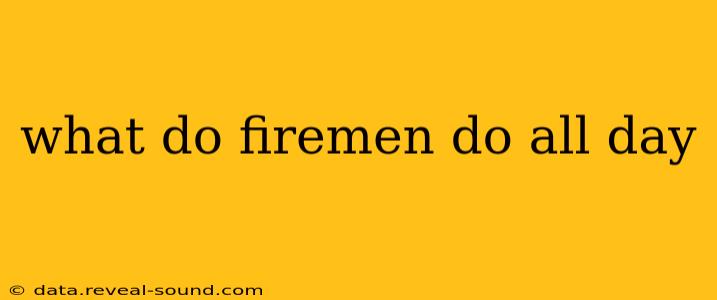The life of a firefighter is far more diverse and demanding than many realize. While battling blazes is a critical part of their job, it’s only a fraction of their daily responsibilities. The reality is that firemen spend a significant portion of their day on preventative measures, training, and maintaining readiness for a wide range of emergencies. Let's delve into a typical day (which, it's important to note, can vary significantly depending on location, station size, and call volume).
What are the typical duties of a firefighter?
Firefighters are highly trained professionals responsible for much more than just extinguishing fires. Their duties encompass a wide spectrum of emergency response and community safety initiatives. These include:
- Fire Suppression: This is the most visible aspect of their work, involving responding to structural fires, wildland fires, vehicle fires, and other fire-related emergencies. This requires rapid response, skillful use of equipment, and strategic firefighting techniques.
- Emergency Medical Services (EMS): In many areas, firefighters are the first responders to medical emergencies, providing crucial life-saving assistance before paramedics arrive. This training includes CPR, first aid, and advanced medical techniques.
- Rescue Operations: Firefighters are often involved in rescuing people from dangerous situations, such as car accidents, building collapses, water rescues, and confined-space incidents. This requires specialized training and equipment.
- Hazardous Materials Response: Dealing with hazardous materials spills and leaks is a critical part of their job, requiring specialized training in identifying, containing, and mitigating the risks associated with various chemicals and substances.
- Prevention and Education: Firefighters play a vital role in preventing fires and educating the public about fire safety. This includes conducting inspections, installing smoke detectors, and giving presentations to schools and community groups.
What do firefighters do when they're not on a call?
The time between emergencies is crucial for maintaining readiness and preparedness. A significant portion of a firefighter's day involves:
- Training and Drills: Continuous training is essential to maintain proficiency in various firefighting techniques, emergency medical procedures, and rescue operations. This includes physical fitness, equipment familiarization, and simulated emergency scenarios.
- Equipment Maintenance and Inspection: Fire trucks, hoses, and other equipment require regular maintenance and inspection to ensure they are in optimal working order. This ensures that they are ready for immediate deployment when an emergency arises.
- Station Maintenance: Keeping the fire station clean, organized, and well-maintained is a collective responsibility. This includes cleaning, organizing equipment, and performing routine station upkeep.
- Record Keeping and Reporting: Firefighters maintain detailed records of their activities, including emergency responses, training sessions, and equipment maintenance. This is vital for accountability and improving emergency response strategies.
- Community Outreach: Many firefighters actively engage in community outreach programs, participating in events, providing safety demonstrations, and building relationships with the people they serve.
What kind of training do firefighters receive?
Becoming a firefighter requires rigorous training and dedication. The training curriculum typically includes:
- Physical Fitness: Firefighters need exceptional physical strength and endurance to handle the demands of their job. Training includes intense physical exercises and drills.
- Firefighting Techniques: This involves learning about fire behavior, suppression strategies, and the use of various firefighting equipment.
- Emergency Medical Response: Firefighters receive extensive training in CPR, first aid, and advanced medical techniques.
- Rescue Operations: Training in high-angle rescue, confined-space rescue, and water rescue is critical.
- Hazardous Materials Response: Specialized training is provided to handle hazardous materials incidents safely and effectively.
What is a typical day like for a firefighter?
A typical day might start with a morning inspection of equipment and the station, followed by physical training or drills. Then, there might be time dedicated to maintenance tasks or administrative duties. This is punctuated by periods of downtime, which are used for studying, completing paperwork, or engaging in other station activities. At any moment, however, the alarm can sound, launching the team into action for any number of emergency calls. The unpredictability is a key part of the job.
How many hours a day do firefighters work?
Firefighters typically work in 24-hour shifts, followed by several days off. This schedule reflects the constant readiness required for emergency response. The exact schedule varies among departments.
The life of a firefighter is a demanding but rewarding career. It combines physical strength, technical expertise, and a profound commitment to serving the community. Their day-to-day activities extend far beyond the image of battling flames, showcasing their dedication to saving lives and protecting the public.
